Watched October 8 - 14, 2007: Mizoguchi in the 1940s
Meito bijomaru / The Famous Sword Bijomaru (Kenji Mizoguchi, 1945)
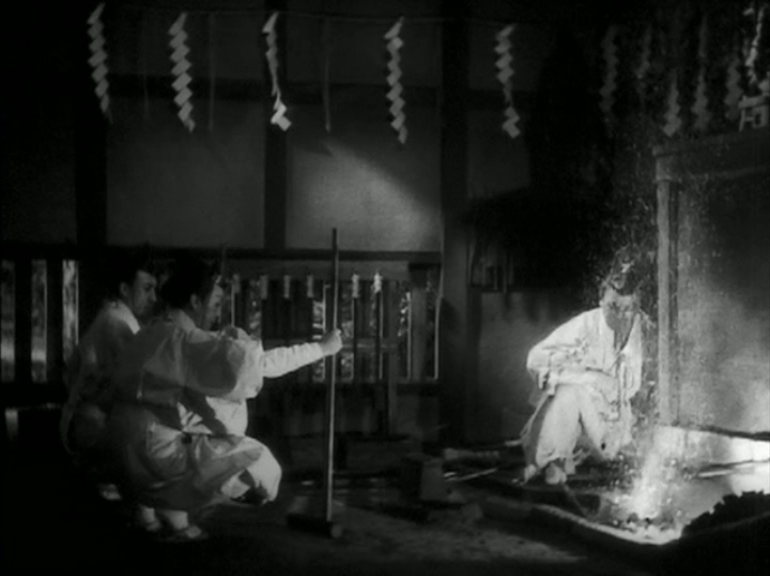 All Mizoguchi films have moments of cinematic magic -- and this one is no exception. Nonetheless, this film probably has less of such moments than any of the other surviving feature films. The script is lumbering.
All Mizoguchi films have moments of cinematic magic -- and this one is no exception. Nonetheless, this film probably has less of such moments than any of the other surviving feature films. The script is lumbering. 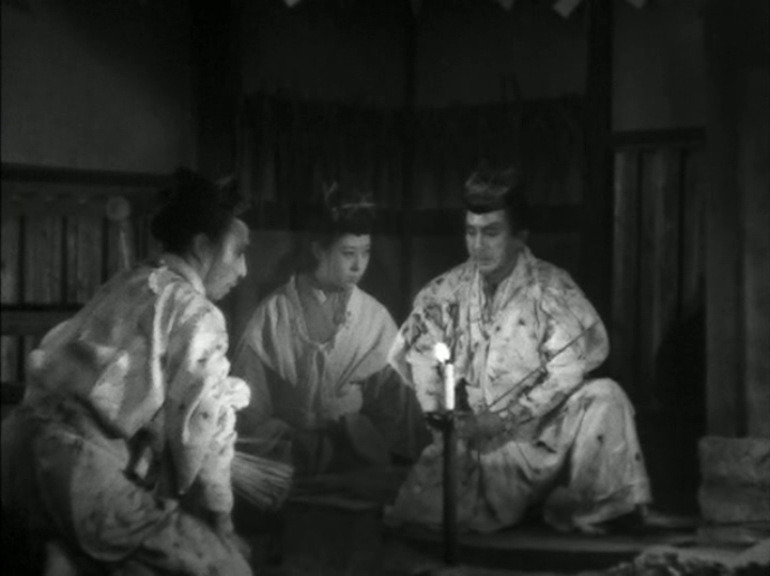 An apprentice swordmaker (Shôtarô Hanayagi) makes a sword for the father of the samurai maiden (Isuzu Yamada) he loves. The sword breaks an inopportune moment, leading to disaster.
An apprentice swordmaker (Shôtarô Hanayagi) makes a sword for the father of the samurai maiden (Isuzu Yamada) he loves. The sword breaks an inopportune moment, leading to disaster. 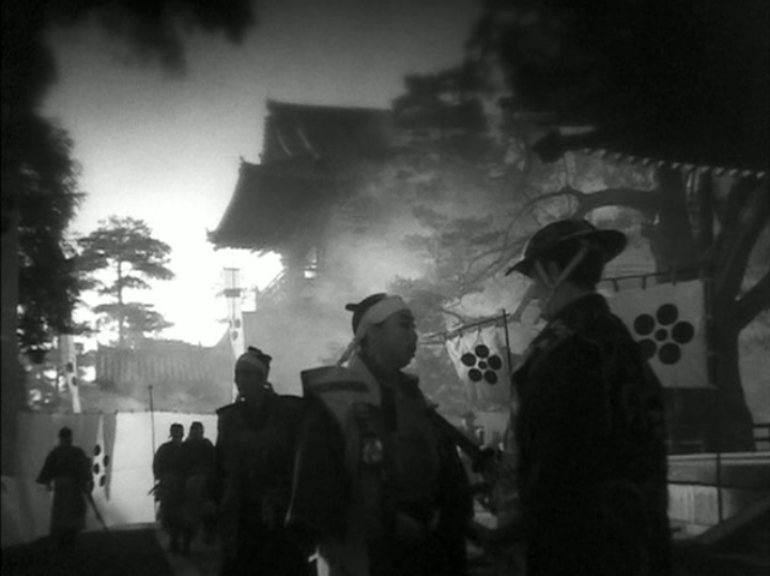 The apprentice goes back to work to make a sword for Yamada to use to take her revenge. His task is complicated when the master swordsmith he works for is killed, by secret agents of the shogun. Hanayagi keeps on working, while Yamada bides her time. The two (along with his trusty helper) join forces just in time for the battle overthrowing the shogun.
The apprentice goes back to work to make a sword for Yamada to use to take her revenge. His task is complicated when the master swordsmith he works for is killed, by secret agents of the shogun. Hanayagi keeps on working, while Yamada bides her time. The two (along with his trusty helper) join forces just in time for the battle overthrowing the shogun.
 The dialog is clunky, the performances are often rather stilted, action sequences are often fairly awkward. No match for either Mizoguchi's own mammoth Genroku Chushingura (47 Loyal Ronin) from 1941 and the more modest (but unconventional and delightful)
The dialog is clunky, the performances are often rather stilted, action sequences are often fairly awkward. No match for either Mizoguchi's own mammoth Genroku Chushingura (47 Loyal Ronin) from 1941 and the more modest (but unconventional and delightful) 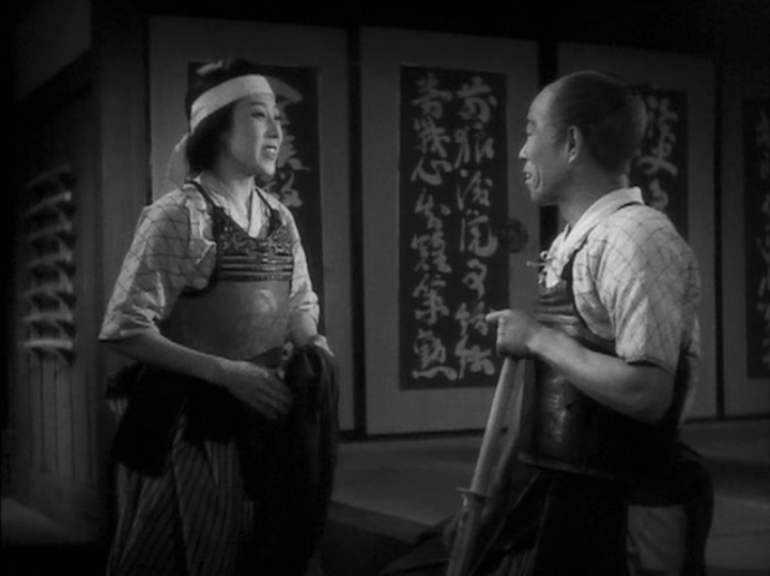 Musashi Miyamoto from 1944 or Naruse's Tale of Archery at the Sanjusangendo (also from 1945). The primary moments that stand out here are ones during the sword making scenes. It's nice that Shochiku released this on DVD, but sad that it ignored the far superior Musashi Miyamoto.
Musashi Miyamoto from 1944 or Naruse's Tale of Archery at the Sanjusangendo (also from 1945). The primary moments that stand out here are ones during the sword making scenes. It's nice that Shochiku released this on DVD, but sad that it ignored the far superior Musashi Miyamoto.
More pictures:
http://i9.photobucket.com/albums/a59/mkerpan/mizoguchi/fsb/bijomaru01.png
http://i9.photobucket.com/albums/a59/mkerpan/mizoguchi/fsb/bijomaru03.png
http://i9.photobucket.com/albums/a59/mkerpan/mizoguchi/fsb/bijomaru05.png
http://i9.photobucket.com/albums/a59/mkerpan/mizoguchi/fsb/bijomaru08.png
http://i9.photobucket.com/albums/a59/mkerpan/mizoguchi/fsb/bijomaru10.png
Yoru no onnatachi / Women of the Night (Kenji Mizoguchi, 1948)
 Movies about women and girls gone bad, and who needed redemption, seem to have been quite a fad in the last couple of years of the 1940s. Naruse did a couple -- Delinquent Girl (1949, lost) and White Beast (1950). And even Ozu (sort of) did one too -- Hen in the Wind. Few of this group are likely to have been as deliriously exploitative as Mizoguchi's film, however.
Movies about women and girls gone bad, and who needed redemption, seem to have been quite a fad in the last couple of years of the 1940s. Naruse did a couple -- Delinquent Girl (1949, lost) and White Beast (1950). And even Ozu (sort of) did one too -- Hen in the Wind. Few of this group are likely to have been as deliriously exploitative as Mizoguchi's film, however.
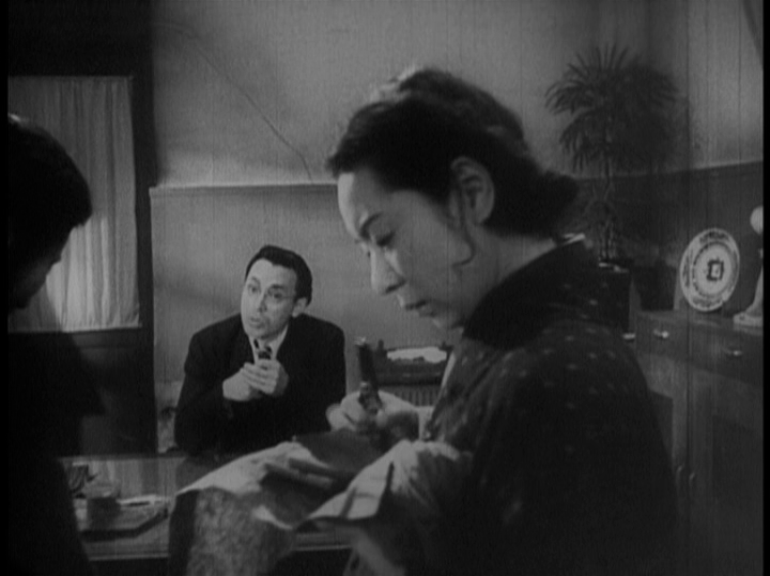 The story starts reasonably enough -- rather like Hen in the Wind. Kinuyo Tanaka plays a woman (with a sick child) whose husband is still missing, three years after the war ends. She continues to hope he is simply a prisoner of war and will return soon. Her hopes are dashed soon (and her child rather unceremoniously dies).
The story starts reasonably enough -- rather like Hen in the Wind. Kinuyo Tanaka plays a woman (with a sick child) whose husband is still missing, three years after the war ends. She continues to hope he is simply a prisoner of war and will return soon. Her hopes are dashed soon (and her child rather unceremoniously dies).  When she runs across her younger sister (Sanae Takasugi), she learns her parents (who had gone off to help colonize Manchuria) are dead too. At first Tanaka gets by, working for a shady import company (and sleeping with the boss). But when police raid the company, and she discovers her sister is also having an affair with her boss, Tanaka turns to the streets to make a living.
When she runs across her younger sister (Sanae Takasugi), she learns her parents (who had gone off to help colonize Manchuria) are dead too. At first Tanaka gets by, working for a shady import company (and sleeping with the boss). But when police raid the company, and she discovers her sister is also having an affair with her boss, Tanaka turns to the streets to make a living. 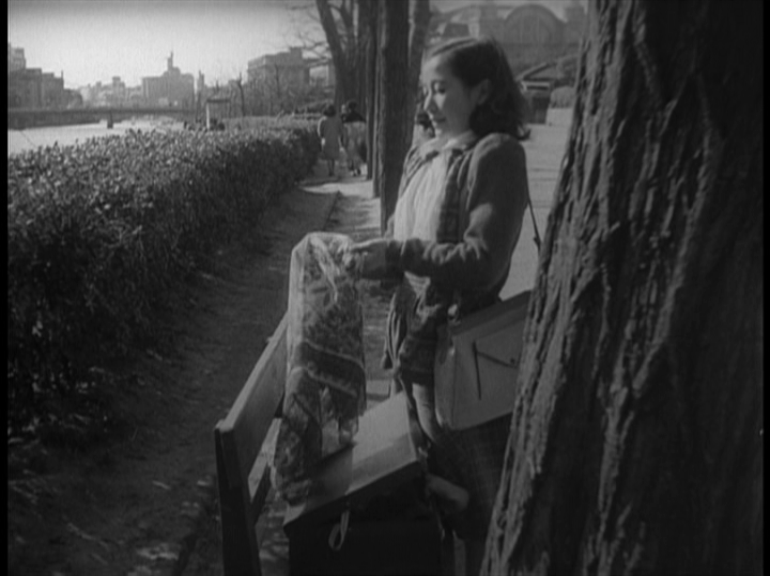 This all happens fairly quickly -- and things get even more tangled soon. Tanaka's teen-aged sister-in-law runs away from home, gets raped and becomes involved in prostitution. Tanaka's sister gets swept up accidentally in an anti-prostitution sweep by the police -- and finds herself in the same detention center as now hard-bitten Tanaka. And things just keep getting worse.
This all happens fairly quickly -- and things get even more tangled soon. Tanaka's teen-aged sister-in-law runs away from home, gets raped and becomes involved in prostitution. Tanaka's sister gets swept up accidentally in an anti-prostitution sweep by the police -- and finds herself in the same detention center as now hard-bitten Tanaka. And things just keep getting worse.
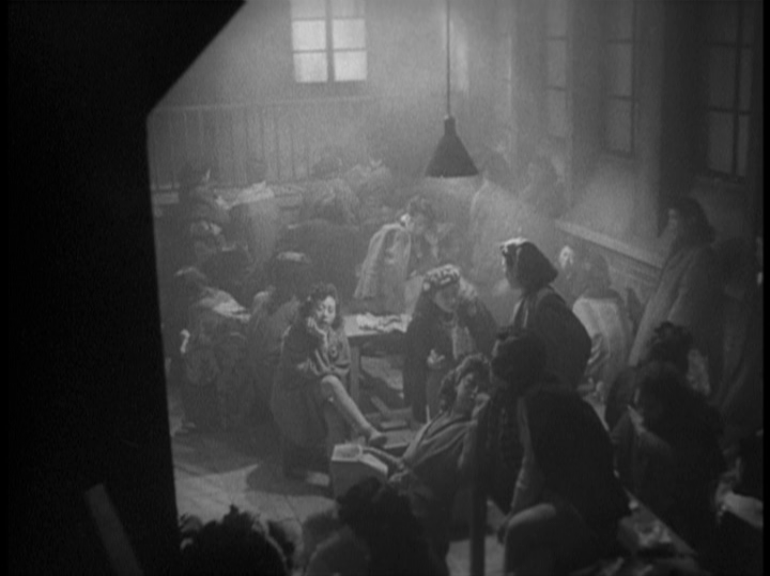 Mizoguchi was apparently sincere in his concern for the many young (and not so young) women with few opportunities being pushed into prostitution (a growth industry, due to the massive American military presence). But the treatment here is only superficially realistic and the melodramatic quotient rises high into the red zone.
Mizoguchi was apparently sincere in his concern for the many young (and not so young) women with few opportunities being pushed into prostitution (a growth industry, due to the massive American military presence). But the treatment here is only superficially realistic and the melodramatic quotient rises high into the red zone. 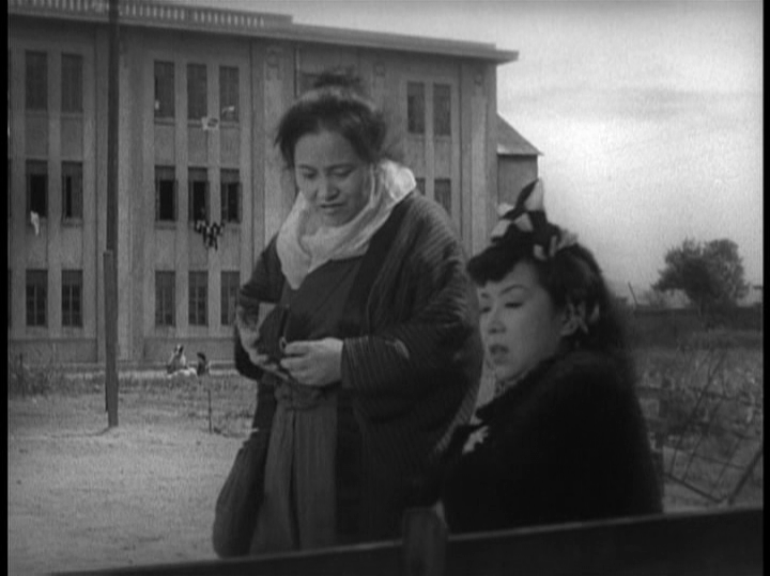 But, while plot-wise, this often seems utterly implausible, the film is filled with so much visual interest, one tends to forgive the script most of the time. The film's best defense is its often sublime images (cinematography by Kôhei Sugiyama) and good performances from Tanaka and Takasugi.Tomie Tsunoda, a novice actress who did a good job playing the young sister-in-law, must have been traumatized by her experiences, as she never appeared in another film thereafter.
But, while plot-wise, this often seems utterly implausible, the film is filled with so much visual interest, one tends to forgive the script most of the time. The film's best defense is its often sublime images (cinematography by Kôhei Sugiyama) and good performances from Tanaka and Takasugi.Tomie Tsunoda, a novice actress who did a good job playing the young sister-in-law, must have been traumatized by her experiences, as she never appeared in another film thereafter.  The character actresses who played supporting parts were also excellent. Of especial note, Kumeko Urabe, who played a roving bawd (who also seemed to dabble in illegal drugs). A film that is hard to categorize -- possibly both highly flawed and almost indispensable to fans of classic Japanese cinema.
The character actresses who played supporting parts were also excellent. Of especial note, Kumeko Urabe, who played a roving bawd (who also seemed to dabble in illegal drugs). A film that is hard to categorize -- possibly both highly flawed and almost indispensable to fans of classic Japanese cinema.
More screen shots:
http://i9.photobucket.com/albums/a59/mkerpan/mizoguchi/wotn/yno01.png
http://i9.photobucket.com/albums/a59/mkerpan/mizoguchi/wotn/yno03.png
http://i9.photobucket.com/albums/a59/mkerpan/mizoguchi/wotn/yno05.png
http://i9.photobucket.com/albums/a59/mkerpan/mizoguchi/wotn/yno07.png
http://i9.photobucket.com/albums/a59/mkerpan/mizoguchi/wotn/yno10.png
http://i9.photobucket.com/albums/a59/mkerpan/mizoguchi/wotn/yno11.png
http://i9.photobucket.com/albums/a59/mkerpan/mizoguchi/wotn/yno13.png
http://i9.photobucket.com/albums/a59/mkerpan/mizoguchi/wotn/yno15.png
http://i9.photobucket.com/albums/a59/mkerpan/mizoguchi/wotn/yno17.png
http://i9.photobucket.com/albums/a59/mkerpan/mizoguchi/wotn/yno18.png
http://i9.photobucket.com/albums/a59/mkerpan/mizoguchi/wotn/yno19.png
http://i9.photobucket.com/albums/a59/mkerpan/mizoguchi/wotn/yno20.png
http://i9.photobucket.com/albums/a59/mkerpan/mizoguchi/wotn/yno21.png
http://i9.photobucket.com/albums/a59/mkerpan/mizoguchi/wotn/yno22.png
http://i9.photobucket.com/albums/a59/mkerpan/mizoguchi/wotn/yno23.png
http://i9.photobucket.com/albums/a59/mkerpan/mizoguchi/wotn/yno24.png
Waga koi wa moenu / My Love Has Been Burning (Kenji Mizoguchi, 1949)
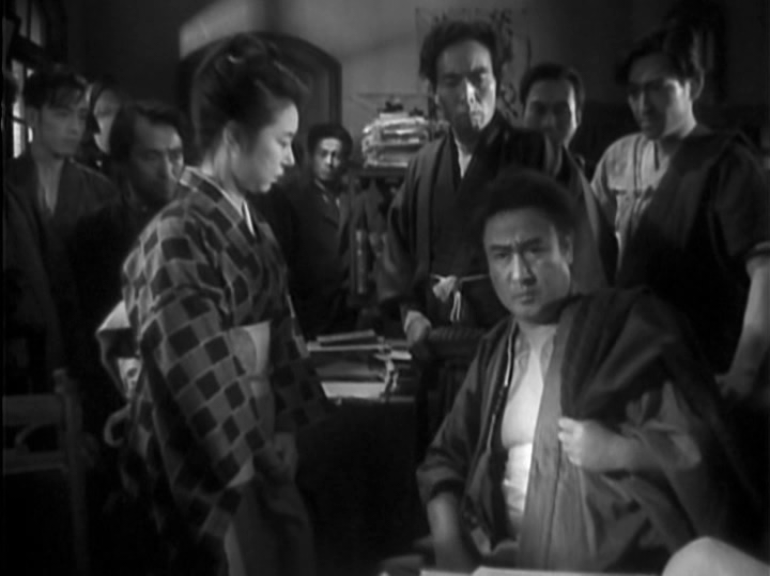 Yet another film ostensibly championing the cause of women's rights (this time during the Meiji era), that sometimes hovers on the verge of exploitativeness and other times comes across as talky and over-didactic. Despite a story by Koga Noda and a script by Kaneto Shindo, this film is often quite dramatically clunky, even though the underlying idea that offers the promise of being reasonably interesting.
Yet another film ostensibly championing the cause of women's rights (this time during the Meiji era), that sometimes hovers on the verge of exploitativeness and other times comes across as talky and over-didactic. Despite a story by Koga Noda and a script by Kaneto Shindo, this film is often quite dramatically clunky, even though the underlying idea that offers the promise of being reasonably interesting.
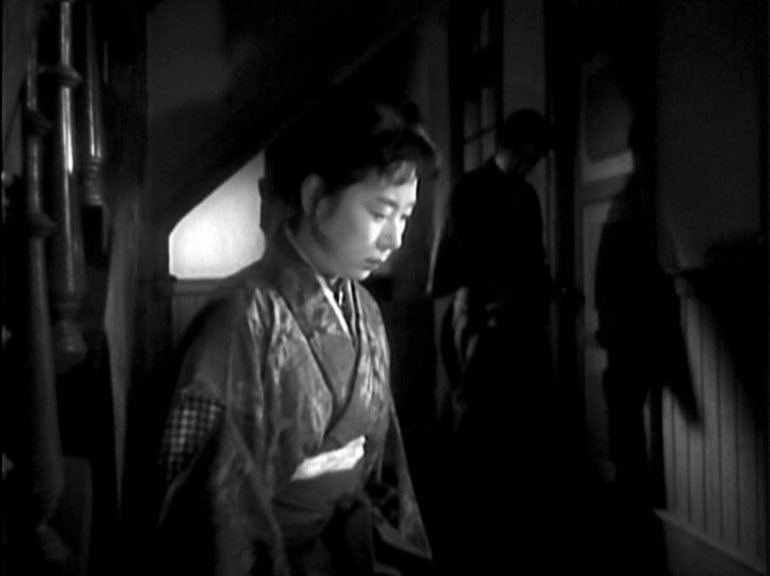 Tanaka plays a provincial political activist for a progressive party, who falls in love with an organizer working in her town. When she follows him to Tokyo, he's less than enthusiastic -- but she finds work and (eventual) romance with one of her party's leaders. She goes to do reconnaissance on a factory which enslaves and mistreats its women workers.
Tanaka plays a provincial political activist for a progressive party, who falls in love with an organizer working in her town. When she follows him to Tokyo, he's less than enthusiastic -- but she finds work and (eventual) romance with one of her party's leaders. She goes to do reconnaissance on a factory which enslaves and mistreats its women workers. 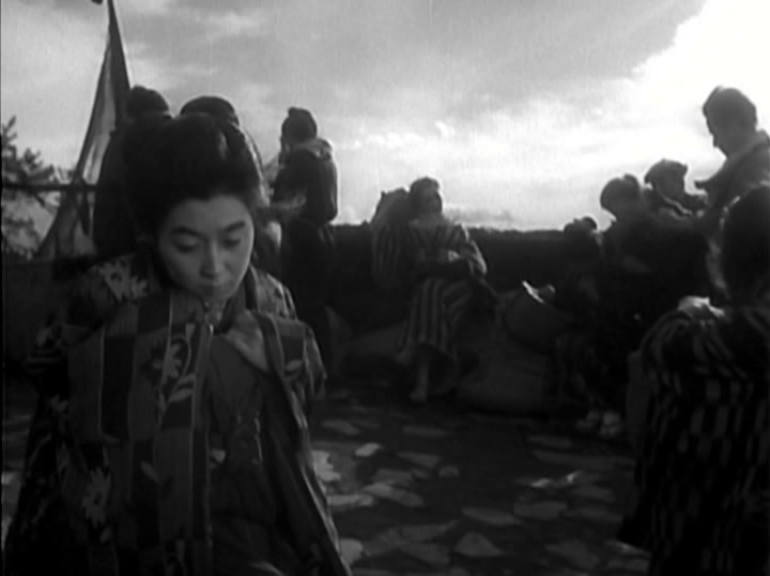 As it turns out, the factory not only overworks its women tremendously, its overseers amuse themselves by beating the employees with whips and raping them. While there, Tanaka encounters a young woman (Mitsuko Mito) who has been sold to the factory by her parents. As it turns out, Mito is on the verge of snapping -- and she soons the whole place on fire.
As it turns out, the factory not only overworks its women tremendously, its overseers amuse themselves by beating the employees with whips and raping them. While there, Tanaka encounters a young woman (Mitsuko Mito) who has been sold to the factory by her parents. As it turns out, Mito is on the verge of snapping -- and she soons the whole place on fire.  As Tanaka tries to escape (dragging along the crazed Mito), they are nabbed by the police. Because of her political connections, Tanaka spends even more time in jail than Mito. And when she finally gets out, she discovers that her boss/lover is philandering (with Mito, of course). Disgusted, Tanaka decides to go back to work, in education at the grasroots level. All thoughout, there is also all sorts of parliamentary maneuvering and campaign mumbo jumbo.
As Tanaka tries to escape (dragging along the crazed Mito), they are nabbed by the police. Because of her political connections, Tanaka spends even more time in jail than Mito. And when she finally gets out, she discovers that her boss/lover is philandering (with Mito, of course). Disgusted, Tanaka decides to go back to work, in education at the grasroots level. All thoughout, there is also all sorts of parliamentary maneuvering and campaign mumbo jumbo.
Structurally, this film is similar to the vastly superior The Love of Sumako the Actress (1947).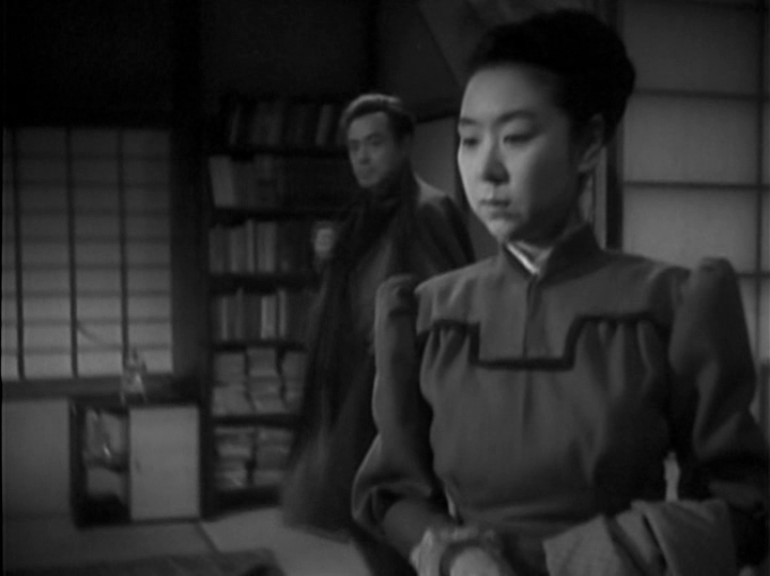 Again, Tanaka plays an initially unsophisticated neophyte who is taken under the wing of an experienced and innovative male leader -- who then suffers grievously due to her mentor's flawed character. But the theatrical context of Sumako seems to have provided more inspiration -- and the fact that Sumako was based on well-known, real people seems to have kept this earlier film from engaging in utterly over-the-top fantasy of both My Love Is Burning (not to mention Women of the Night). My Love Is Burning has some visually impressive scenes, though some of these also happen to be the scenes that are most dramatically "improbable".
Again, Tanaka plays an initially unsophisticated neophyte who is taken under the wing of an experienced and innovative male leader -- who then suffers grievously due to her mentor's flawed character. But the theatrical context of Sumako seems to have provided more inspiration -- and the fact that Sumako was based on well-known, real people seems to have kept this earlier film from engaging in utterly over-the-top fantasy of both My Love Is Burning (not to mention Women of the Night). My Love Is Burning has some visually impressive scenes, though some of these also happen to be the scenes that are most dramatically "improbable". 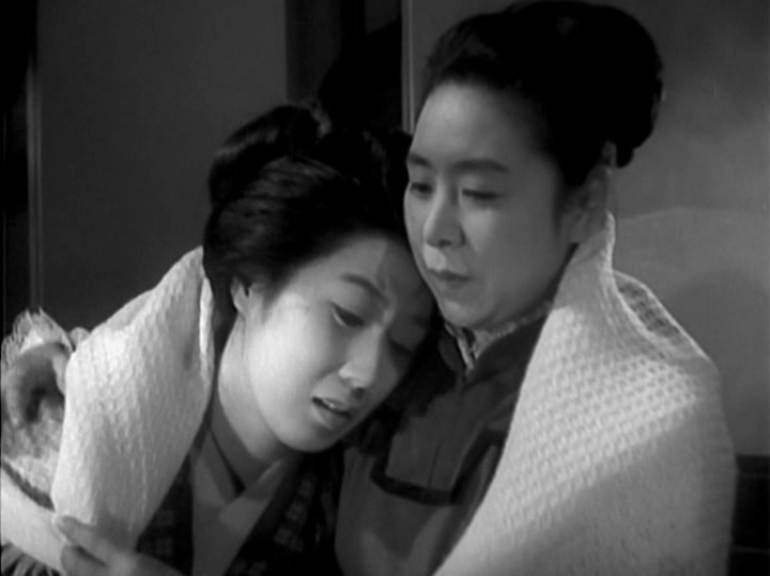 It is interesting to note that the most problematic of Mizoguchi's occupation era films (a category that also includes his Victory of Women) have a lot in common with the least of his war-time films (Famed Sword Bijomaru, see above). These all seem as if they try to make up for lack of a solid dramatic core by ratcheting up the intensity and extravagance of the plots (a problem that stretched -- intermittently -- all the way through 1951 -- with Lady from Musashino).
It is interesting to note that the most problematic of Mizoguchi's occupation era films (a category that also includes his Victory of Women) have a lot in common with the least of his war-time films (Famed Sword Bijomaru, see above). These all seem as if they try to make up for lack of a solid dramatic core by ratcheting up the intensity and extravagance of the plots (a problem that stretched -- intermittently -- all the way through 1951 -- with Lady from Musashino).
A few more pictures:
http://i9.photobucket.com/albums/a59/mkerpan/mizoguchi/mlib/burning01.png
http://i9.photobucket.com/albums/a59/mkerpan/mizoguchi/mlib/burning03.png
http://i9.photobucket.com/albums/a59/mkerpan/mizoguchi/mlib/burning05.png
http://i9.photobucket.com/albums/a59/mkerpan/mizoguchi/mlib/burning06.png
http://i9.photobucket.com/albums/a59/mkerpan/mizoguchi/mlib/burning07.png
 All Mizoguchi films have moments of cinematic magic -- and this one is no exception. Nonetheless, this film probably has less of such moments than any of the other surviving feature films. The script is lumbering.
All Mizoguchi films have moments of cinematic magic -- and this one is no exception. Nonetheless, this film probably has less of such moments than any of the other surviving feature films. The script is lumbering.  An apprentice swordmaker (Shôtarô Hanayagi) makes a sword for the father of the samurai maiden (Isuzu Yamada) he loves. The sword breaks an inopportune moment, leading to disaster.
An apprentice swordmaker (Shôtarô Hanayagi) makes a sword for the father of the samurai maiden (Isuzu Yamada) he loves. The sword breaks an inopportune moment, leading to disaster.  The apprentice goes back to work to make a sword for Yamada to use to take her revenge. His task is complicated when the master swordsmith he works for is killed, by secret agents of the shogun. Hanayagi keeps on working, while Yamada bides her time. The two (along with his trusty helper) join forces just in time for the battle overthrowing the shogun.
The apprentice goes back to work to make a sword for Yamada to use to take her revenge. His task is complicated when the master swordsmith he works for is killed, by secret agents of the shogun. Hanayagi keeps on working, while Yamada bides her time. The two (along with his trusty helper) join forces just in time for the battle overthrowing the shogun. The dialog is clunky, the performances are often rather stilted, action sequences are often fairly awkward. No match for either Mizoguchi's own mammoth Genroku Chushingura (47 Loyal Ronin) from 1941 and the more modest (but unconventional and delightful)
The dialog is clunky, the performances are often rather stilted, action sequences are often fairly awkward. No match for either Mizoguchi's own mammoth Genroku Chushingura (47 Loyal Ronin) from 1941 and the more modest (but unconventional and delightful)  Musashi Miyamoto from 1944 or Naruse's Tale of Archery at the Sanjusangendo (also from 1945). The primary moments that stand out here are ones during the sword making scenes. It's nice that Shochiku released this on DVD, but sad that it ignored the far superior Musashi Miyamoto.
Musashi Miyamoto from 1944 or Naruse's Tale of Archery at the Sanjusangendo (also from 1945). The primary moments that stand out here are ones during the sword making scenes. It's nice that Shochiku released this on DVD, but sad that it ignored the far superior Musashi Miyamoto.More pictures:
http://i9.photobucket.com/albums/a59/mkerpan/mizoguchi/fsb/bijomaru01.png
http://i9.photobucket.com/albums/a59/mkerpan/mizoguchi/fsb/bijomaru03.png
http://i9.photobucket.com/albums/a59/mkerpan/mizoguchi/fsb/bijomaru05.png
http://i9.photobucket.com/albums/a59/mkerpan/mizoguchi/fsb/bijomaru08.png
http://i9.photobucket.com/albums/a59/mkerpan/mizoguchi/fsb/bijomaru10.png
Yoru no onnatachi / Women of the Night (Kenji Mizoguchi, 1948)
 Movies about women and girls gone bad, and who needed redemption, seem to have been quite a fad in the last couple of years of the 1940s. Naruse did a couple -- Delinquent Girl (1949, lost) and White Beast (1950). And even Ozu (sort of) did one too -- Hen in the Wind. Few of this group are likely to have been as deliriously exploitative as Mizoguchi's film, however.
Movies about women and girls gone bad, and who needed redemption, seem to have been quite a fad in the last couple of years of the 1940s. Naruse did a couple -- Delinquent Girl (1949, lost) and White Beast (1950). And even Ozu (sort of) did one too -- Hen in the Wind. Few of this group are likely to have been as deliriously exploitative as Mizoguchi's film, however. The story starts reasonably enough -- rather like Hen in the Wind. Kinuyo Tanaka plays a woman (with a sick child) whose husband is still missing, three years after the war ends. She continues to hope he is simply a prisoner of war and will return soon. Her hopes are dashed soon (and her child rather unceremoniously dies).
The story starts reasonably enough -- rather like Hen in the Wind. Kinuyo Tanaka plays a woman (with a sick child) whose husband is still missing, three years after the war ends. She continues to hope he is simply a prisoner of war and will return soon. Her hopes are dashed soon (and her child rather unceremoniously dies).  When she runs across her younger sister (Sanae Takasugi), she learns her parents (who had gone off to help colonize Manchuria) are dead too. At first Tanaka gets by, working for a shady import company (and sleeping with the boss). But when police raid the company, and she discovers her sister is also having an affair with her boss, Tanaka turns to the streets to make a living.
When she runs across her younger sister (Sanae Takasugi), she learns her parents (who had gone off to help colonize Manchuria) are dead too. At first Tanaka gets by, working for a shady import company (and sleeping with the boss). But when police raid the company, and she discovers her sister is also having an affair with her boss, Tanaka turns to the streets to make a living.  This all happens fairly quickly -- and things get even more tangled soon. Tanaka's teen-aged sister-in-law runs away from home, gets raped and becomes involved in prostitution. Tanaka's sister gets swept up accidentally in an anti-prostitution sweep by the police -- and finds herself in the same detention center as now hard-bitten Tanaka. And things just keep getting worse.
This all happens fairly quickly -- and things get even more tangled soon. Tanaka's teen-aged sister-in-law runs away from home, gets raped and becomes involved in prostitution. Tanaka's sister gets swept up accidentally in an anti-prostitution sweep by the police -- and finds herself in the same detention center as now hard-bitten Tanaka. And things just keep getting worse. Mizoguchi was apparently sincere in his concern for the many young (and not so young) women with few opportunities being pushed into prostitution (a growth industry, due to the massive American military presence). But the treatment here is only superficially realistic and the melodramatic quotient rises high into the red zone.
Mizoguchi was apparently sincere in his concern for the many young (and not so young) women with few opportunities being pushed into prostitution (a growth industry, due to the massive American military presence). But the treatment here is only superficially realistic and the melodramatic quotient rises high into the red zone.  But, while plot-wise, this often seems utterly implausible, the film is filled with so much visual interest, one tends to forgive the script most of the time. The film's best defense is its often sublime images (cinematography by Kôhei Sugiyama) and good performances from Tanaka and Takasugi.Tomie Tsunoda, a novice actress who did a good job playing the young sister-in-law, must have been traumatized by her experiences, as she never appeared in another film thereafter.
But, while plot-wise, this often seems utterly implausible, the film is filled with so much visual interest, one tends to forgive the script most of the time. The film's best defense is its often sublime images (cinematography by Kôhei Sugiyama) and good performances from Tanaka and Takasugi.Tomie Tsunoda, a novice actress who did a good job playing the young sister-in-law, must have been traumatized by her experiences, as she never appeared in another film thereafter.  The character actresses who played supporting parts were also excellent. Of especial note, Kumeko Urabe, who played a roving bawd (who also seemed to dabble in illegal drugs). A film that is hard to categorize -- possibly both highly flawed and almost indispensable to fans of classic Japanese cinema.
The character actresses who played supporting parts were also excellent. Of especial note, Kumeko Urabe, who played a roving bawd (who also seemed to dabble in illegal drugs). A film that is hard to categorize -- possibly both highly flawed and almost indispensable to fans of classic Japanese cinema.More screen shots:
http://i9.photobucket.com/albums/a59/mkerpan/mizoguchi/wotn/yno01.png
http://i9.photobucket.com/albums/a59/mkerpan/mizoguchi/wotn/yno03.png
http://i9.photobucket.com/albums/a59/mkerpan/mizoguchi/wotn/yno05.png
http://i9.photobucket.com/albums/a59/mkerpan/mizoguchi/wotn/yno07.png
http://i9.photobucket.com/albums/a59/mkerpan/mizoguchi/wotn/yno10.png
http://i9.photobucket.com/albums/a59/mkerpan/mizoguchi/wotn/yno11.png
http://i9.photobucket.com/albums/a59/mkerpan/mizoguchi/wotn/yno13.png
http://i9.photobucket.com/albums/a59/mkerpan/mizoguchi/wotn/yno15.png
http://i9.photobucket.com/albums/a59/mkerpan/mizoguchi/wotn/yno17.png
http://i9.photobucket.com/albums/a59/mkerpan/mizoguchi/wotn/yno18.png
http://i9.photobucket.com/albums/a59/mkerpan/mizoguchi/wotn/yno19.png
http://i9.photobucket.com/albums/a59/mkerpan/mizoguchi/wotn/yno20.png
http://i9.photobucket.com/albums/a59/mkerpan/mizoguchi/wotn/yno21.png
http://i9.photobucket.com/albums/a59/mkerpan/mizoguchi/wotn/yno22.png
http://i9.photobucket.com/albums/a59/mkerpan/mizoguchi/wotn/yno23.png
http://i9.photobucket.com/albums/a59/mkerpan/mizoguchi/wotn/yno24.png
Waga koi wa moenu / My Love Has Been Burning (Kenji Mizoguchi, 1949)
 Yet another film ostensibly championing the cause of women's rights (this time during the Meiji era), that sometimes hovers on the verge of exploitativeness and other times comes across as talky and over-didactic. Despite a story by Koga Noda and a script by Kaneto Shindo, this film is often quite dramatically clunky, even though the underlying idea that offers the promise of being reasonably interesting.
Yet another film ostensibly championing the cause of women's rights (this time during the Meiji era), that sometimes hovers on the verge of exploitativeness and other times comes across as talky and over-didactic. Despite a story by Koga Noda and a script by Kaneto Shindo, this film is often quite dramatically clunky, even though the underlying idea that offers the promise of being reasonably interesting. Tanaka plays a provincial political activist for a progressive party, who falls in love with an organizer working in her town. When she follows him to Tokyo, he's less than enthusiastic -- but she finds work and (eventual) romance with one of her party's leaders. She goes to do reconnaissance on a factory which enslaves and mistreats its women workers.
Tanaka plays a provincial political activist for a progressive party, who falls in love with an organizer working in her town. When she follows him to Tokyo, he's less than enthusiastic -- but she finds work and (eventual) romance with one of her party's leaders. She goes to do reconnaissance on a factory which enslaves and mistreats its women workers.  As it turns out, the factory not only overworks its women tremendously, its overseers amuse themselves by beating the employees with whips and raping them. While there, Tanaka encounters a young woman (Mitsuko Mito) who has been sold to the factory by her parents. As it turns out, Mito is on the verge of snapping -- and she soons the whole place on fire.
As it turns out, the factory not only overworks its women tremendously, its overseers amuse themselves by beating the employees with whips and raping them. While there, Tanaka encounters a young woman (Mitsuko Mito) who has been sold to the factory by her parents. As it turns out, Mito is on the verge of snapping -- and she soons the whole place on fire.  As Tanaka tries to escape (dragging along the crazed Mito), they are nabbed by the police. Because of her political connections, Tanaka spends even more time in jail than Mito. And when she finally gets out, she discovers that her boss/lover is philandering (with Mito, of course). Disgusted, Tanaka decides to go back to work, in education at the grasroots level. All thoughout, there is also all sorts of parliamentary maneuvering and campaign mumbo jumbo.
As Tanaka tries to escape (dragging along the crazed Mito), they are nabbed by the police. Because of her political connections, Tanaka spends even more time in jail than Mito. And when she finally gets out, she discovers that her boss/lover is philandering (with Mito, of course). Disgusted, Tanaka decides to go back to work, in education at the grasroots level. All thoughout, there is also all sorts of parliamentary maneuvering and campaign mumbo jumbo.Structurally, this film is similar to the vastly superior The Love of Sumako the Actress (1947).
 Again, Tanaka plays an initially unsophisticated neophyte who is taken under the wing of an experienced and innovative male leader -- who then suffers grievously due to her mentor's flawed character. But the theatrical context of Sumako seems to have provided more inspiration -- and the fact that Sumako was based on well-known, real people seems to have kept this earlier film from engaging in utterly over-the-top fantasy of both My Love Is Burning (not to mention Women of the Night). My Love Is Burning has some visually impressive scenes, though some of these also happen to be the scenes that are most dramatically "improbable".
Again, Tanaka plays an initially unsophisticated neophyte who is taken under the wing of an experienced and innovative male leader -- who then suffers grievously due to her mentor's flawed character. But the theatrical context of Sumako seems to have provided more inspiration -- and the fact that Sumako was based on well-known, real people seems to have kept this earlier film from engaging in utterly over-the-top fantasy of both My Love Is Burning (not to mention Women of the Night). My Love Is Burning has some visually impressive scenes, though some of these also happen to be the scenes that are most dramatically "improbable".  It is interesting to note that the most problematic of Mizoguchi's occupation era films (a category that also includes his Victory of Women) have a lot in common with the least of his war-time films (Famed Sword Bijomaru, see above). These all seem as if they try to make up for lack of a solid dramatic core by ratcheting up the intensity and extravagance of the plots (a problem that stretched -- intermittently -- all the way through 1951 -- with Lady from Musashino).
It is interesting to note that the most problematic of Mizoguchi's occupation era films (a category that also includes his Victory of Women) have a lot in common with the least of his war-time films (Famed Sword Bijomaru, see above). These all seem as if they try to make up for lack of a solid dramatic core by ratcheting up the intensity and extravagance of the plots (a problem that stretched -- intermittently -- all the way through 1951 -- with Lady from Musashino).A few more pictures:
http://i9.photobucket.com/albums/a59/mkerpan/mizoguchi/mlib/burning01.png
http://i9.photobucket.com/albums/a59/mkerpan/mizoguchi/mlib/burning03.png
http://i9.photobucket.com/albums/a59/mkerpan/mizoguchi/mlib/burning05.png
http://i9.photobucket.com/albums/a59/mkerpan/mizoguchi/mlib/burning06.png
http://i9.photobucket.com/albums/a59/mkerpan/mizoguchi/mlib/burning07.png
Comments